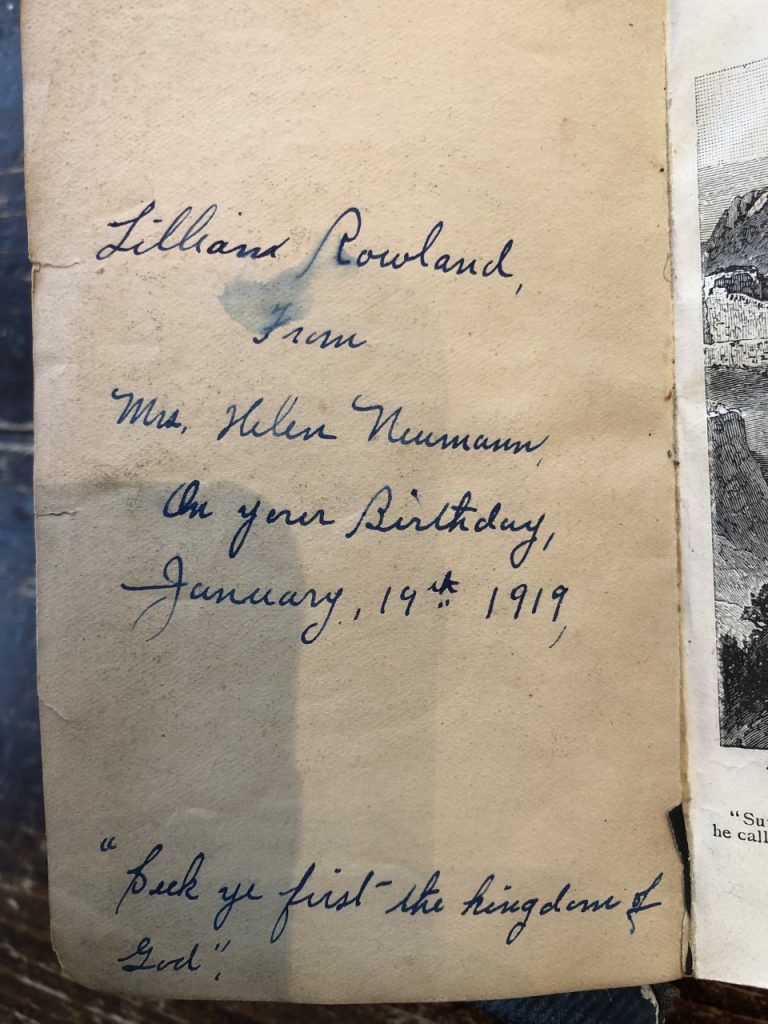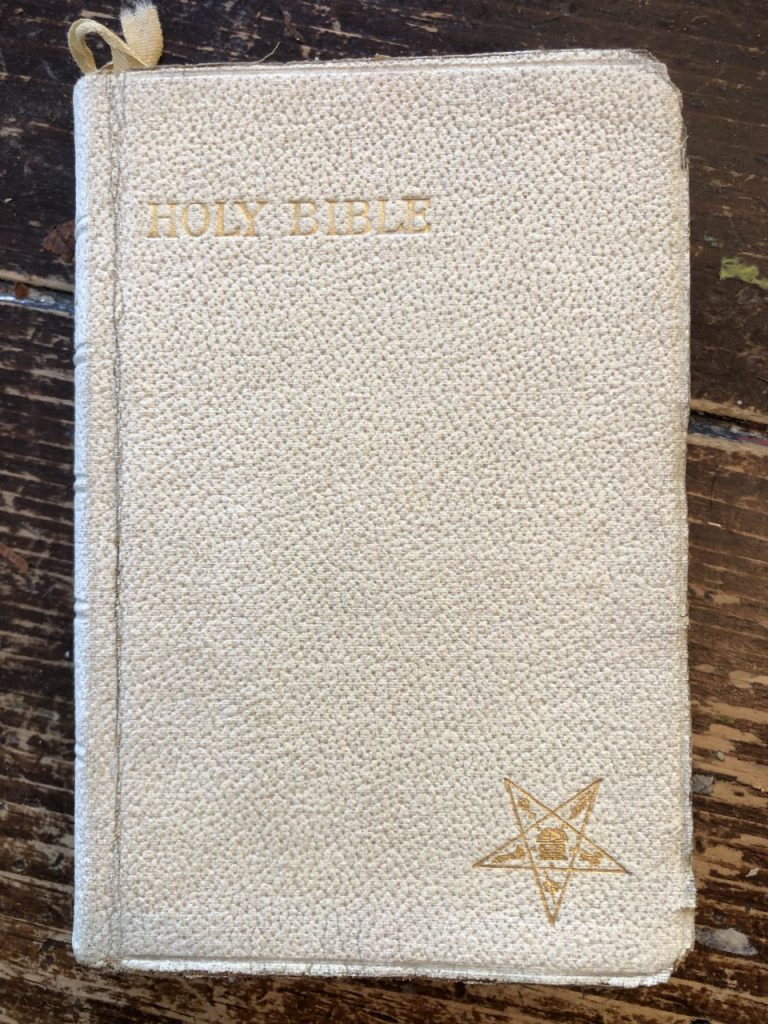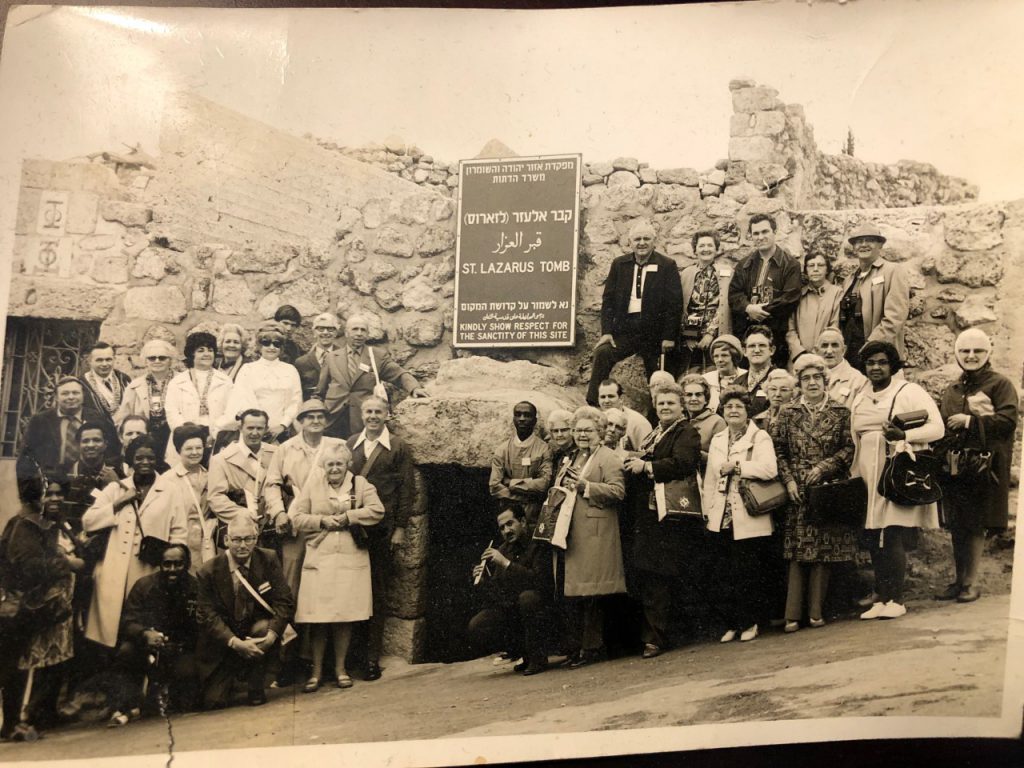My dad hates pumpkin pie. He reminds us of this fact every Thanksgiving as he eats a giant slice of it. He always adds “But I love my grandmother. She always baked pumpkin pie on Thanksgiving.”
My great-grandmother, Lilian Katala, was born in New York City in 1908 to a working-class, Methodist family. Lilian was a kind, religious woman. As she faced the trials of womanhood throughout the 20th century, her faith and her Bibles remained a cornerstone of support. Over a century after she was born, all I have left of her is her Bibles.
The first is a small illustrated Bible. It was gifted to her on her eleventh birthday. It perhaps served as a religious introduction for children during this era. The illustrations would help young readers who may not yet be equipped to fully understand all of the passages yet, and they also help to highlight the importance of specific Bible stories. This reinforces the authority of specific stories such as David and Goliath as worthy of special interest to young readers.

The gift-giver, Mrs. Neumann, has been forgotten through the years. Although her identity and relationship to Lilian are unknown, the Bible would have been of great value to a young working-class girl. As Bottingheimer notes, Bibles for poor children during this time were “bound in dull tan, gray, or blue paper, the richest child’s in…leather with gold stamped lettering” (100). The leather binding and gold lettering of this particular Bible are indicative of its value.
Later in life, she was given a small, paperback copy of the New Testament from The Bowery Mission, a charity in a rough Manhattan neighborhood dedicated to serving the destitute.. Lilian never lived in Manhattan, but she did work in the Manhattan Jewelry District where she strung pearls. The Bible itself is small, paperback, and well worn. Its cheap binding and humble appearance is a sharp contrast to the Illustrated Bible. Near the front page, it contains a pledge against alcohol, with a blank place for someone to sign and for a witness. This showcases the importance of the teetotalism movement in religious communities during the early to mid 20th century. The pledge was deemed so important by the charity, that it precedes even the words of Jesus. Fascinatingly, no one ever signed. By family accounts, Lilian did like to drink. The blank pledge against alcohol serves as a hint her drinking was not a sudden development of relaxed morals in her twilight years. She was an honest woman. However, she did abstain from drinking around her oldest daughter, who later struggled with alcoholism.

I suspect Lilian was not a volunteer but was being served by the Bowery Mission during the end of the Great Depression. Her first cousin and first husband, James Rowland, died shortly after they adopted their only child, a baby named Betty in 1938. Being a single mother during the economic pressures and impending war was difficult. During this time of hardship, she would have turned to her faith and the Bible for support.
In 1944, she was granted a small, white, lady’s bible with gold gilded edges. A Martha inscribed on the inside of the front cover “Dear Lilian, may you find much joy and happiness as a member of our Order and Chapter.” The Bible was an introductory text to The Order of the Eastern Star, likely a chapter located at the Wood Haven Methodist in Queens, Lilian’s Church. The Bible contains more than a delicate flair, prior to the official Bible, there is a note to the initiate, explaining the purpose of the organization to work towards the emancipation of women, proclaiming them equal to men. The return of the savior and Biblical women are heralded as evidence of the innate equality between sexes. This was still a progressive stance in the 1940s, but one that aligned with Lilian’s values. This also reflected the growing trend of increased empowerment of women as they entered the workforce.

Two years prior to receiving this gift, Lilian gave birth to her only child with her second husband, Frank Katala.

Frank was a difficult man. He has been described as a hard-headed drama queen who always needed to be the boss. All recount him pretending to have heart attacks during disagreements. However, in the spirit of women’s empowerment, Lilian remained largely independent. He worked as a dye setter in a machine shop in Bristol, Connecticut during the week. This meant that Lilian spent the weeks alone with Betty and Martha, only seeing her husband on the weekends during these years.
Although he had a difficult temperament, Frank was the gift-giver of the final Bible, a large leather-bound copy now cracked from use. It was given to Lilian for Christmas in 1946, as the brief inscription “a Merry Xmas Lilian” notes. They were still living in New York at that point, but there are still clues towards where their journey took them from there. The very first Bible given to her as a child and the Bowery Bible contain an address on the back for the Clearwater, Florida trailer she and Frank moved to in the 1960s.
Scraps of paper from legal documents, legal pads, and pamphlets begin to tell the story here. She wrote names and her favorite hymns. There is a well-preserved copy of a pamphlet advertising missionary work to spread Methodism in Alaska. She never went.
Her faith took her in a different direction. She had a lifelong dream of returning to Israel. In the 1970s, Lilian made one final move to Athens, Georgia to live near family and then joined the Oconee Street United Methodist, an integrated church. There, she finally had an opportunity to make her dream happen.

After surviving the Spanish flu pandemic, the Great Depression, single motherhood, two world wars, several moves, and a million other trials in her life, Lilian was able to see the Holy Land. She made it.
Despite her hardships, her dream came true. Not too long after, Lilian quietly died in Athens, Georgia in 1987.
Sources
Bottigheimer, Ruth B. The Bible for Children : From the Age of Gutenberg to the Present. Yale University Press, 1996. EBSCOhost, search.ebscohost.com/login.aspx?direct=true&AuthType=ip,shib&db=cat06564a&AN=uga.9915421763902959&site=eds-live.
Holy Bible Illustrated. Oxford University Press.
The Holy Bible. Oxford University Press, 1935.
The Holy Bible. Scofield Reference Edition. Oxford University Press, 1909.
The New Testament. American Bible Society, 1885.